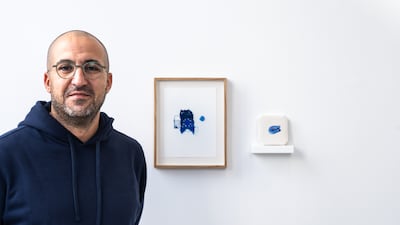The charming coastal city of Limassol this month played host to the inaugural Vima Art Fair, the first international contemporary art fair in Cyprus.
Gathering artists and galleries from around the Mediterranean and beyond, Vima – which in Greek means step, podium or platform – sought to form meaningful connections between the growing local art ecosystems in Cyprus and its neighbouring countries, acting as both a geographical and cultural bridge between East and West.
Held between May 15 and 18 at a derelict industrial complex along the Mediterranean Sea, the inaugural fair presented 27 commercial and non-profit galleries, and about 100 artists from more than 20 countries. This included Takeover and Galerie Tanit from Beirut, and Nika Project Space, a gallery in Dubai, plus an array of artists from the Middle East and North Africa.
“The history of Cyprus is complicated and multilayered but, despite its contradictory background, I feel it provides a welcoming atmosphere for people who live here and acts as a connector or facilitator to many cultures in the region,” Vima co-founder Lara Kotreleva tells The National. “Cyprus sits between the modern and the ancient with its maritime trade routes and migratory lines, and is a destination for lovers of culture and travel.
“We felt there was an obvious gap for an art fair here, and that we could do something special, more inspired by the essence of Cyprus and different from what else is happening on the global art scene,” she adds. “We also wanted to have both East and West because, typically, these territories are kept separate at other art fairs. However, in Cyprus, these cultures and histories are both present, so we have many local Cypriot and Greek galleries, as well as others from Beirut and the UAE.”

Alongside the commercial section was a special Curatorial Project, which will each year invite an international curator to create an immersive show that inspired dialogue among artists from various regions.
Ludovic Delalande, a curator from Paris, created The Posterity of the Sun, a group exhibition spread over the ruined, roofless warehouses, with 16 artists and Palestinian writer Karim Kattan, whose work for the show was created during a residency in Nicosia, Cyprus.
The title draws from Rene Char and Albert Camus’s 1950s novel, La Posterite du Soleil, which explores notions of friendship under the summer sun. The exhibition took this concept and used the sun as a uniting force, free of borders and politics, and an indifferent presence that can give life but also destroy.
“As a curator, I tend to conceive a project directly from its context. This opportunity has enabled me to discover Cyprus’s truly dynamic art scene and to explore multiple narratives from a unique territory that is a crossroads of sorts,” Delalande says. “Depending on your point of view, it can be the last country of the western world, or it can be the beginning of the Middle East. I like how a shift in perception can change the way to think about something, and these artists also do that.”

The works on show – by the likes of Monia Ben Hamouda, Younes Ben Slimane, Valentino Charalambous, Simone Fattal, Adrian Pepe and Leontios Toumpouris – are diverse, ranging from large-scale textile installations to small ceramic pieces. All, however, explore nature, migration or heritage in some way.
Palestinian artist Majd Abdel Hamid’s work – small blue textile pieces that rethink traditional embroidery and draw inspiration from the sea – sit in direct dialogue with several bronze statues by Fattal. The solid, harsh materials of Fattal’s pieces offer a pleasing contrast to Abdel Hamid’s delicate swatches, both exploring a relationship with water in their own way.
“It's an ongoing series called Ode to the Sea, and it's basically a travel journal I started in Tunisia’s Kerkennah Islands,” Abdel Hamid says. “Chapter two is Beirut and chapter three is Anafi island in Greece.
“The idea is to make a material travel journal that's based on photography, things I collect, textiles and my own embroidery, which I compose into small artworks. I'm preoccupied with this idea of non-verbal poetry, and this series is all about how I interact with these places and preserve experiences.”
Over in the galleries section, The Third Line from Dubai featured a mix of emerging and established regional names, such as Hassan Hajjaj, Rana Begum and artist duo Joana Hadjithomas and Khalil Jreige, alongside Anuar Khalifi, Sara Naim and Bady Dalloul.
The fair also included a diverse public and parallel programme of tours, talks, live music, site-specific performances and off-site exhibitions that brought Limassol to life – as well as trips to the country’s capital, Nicosia. Future shows are expected to push programming further and become an exciting fixture on the regional art scene.
The Third Line founder Sunny Rahbar says the fair came as a pleasant surprise.
“When I opened my gallery 20 years ago, there was very little representation for artists from this side of the world,” she says. “Often we were going to fairs in the West, like Frieze London and Art Basel Miami. There wasn’t enough on our side of the world that was of the same calibre.
“I think this fair makes a lot more sense than me going to London or Paris, so I’m excited to see how it grows.”


